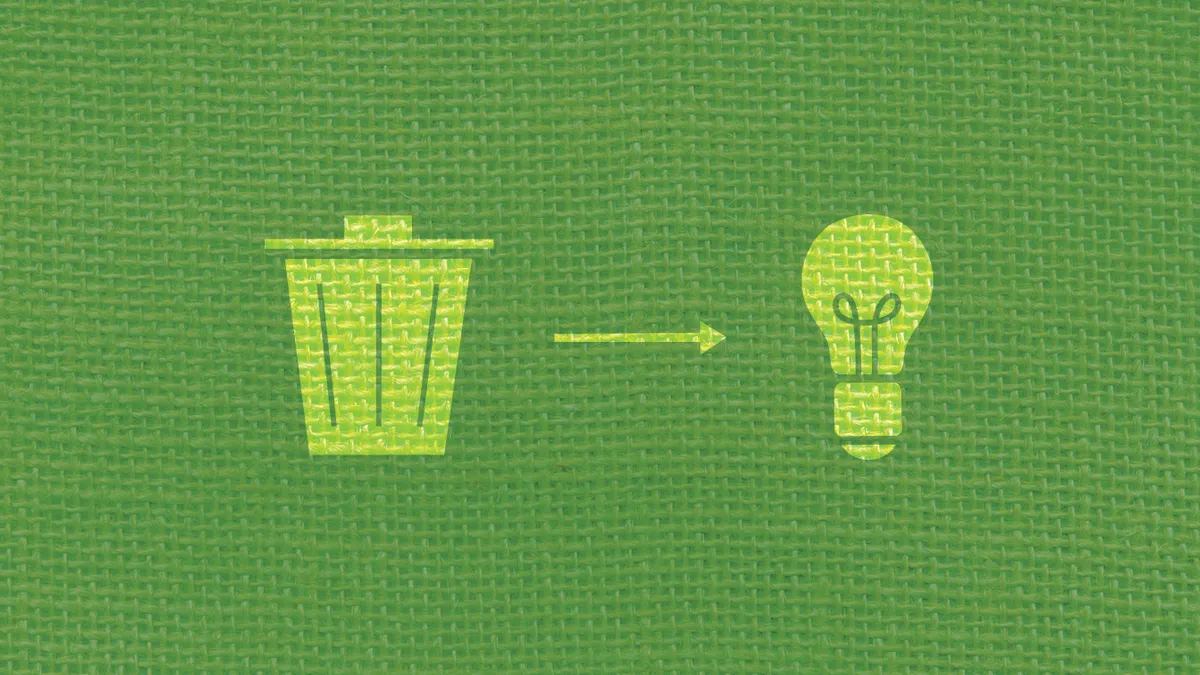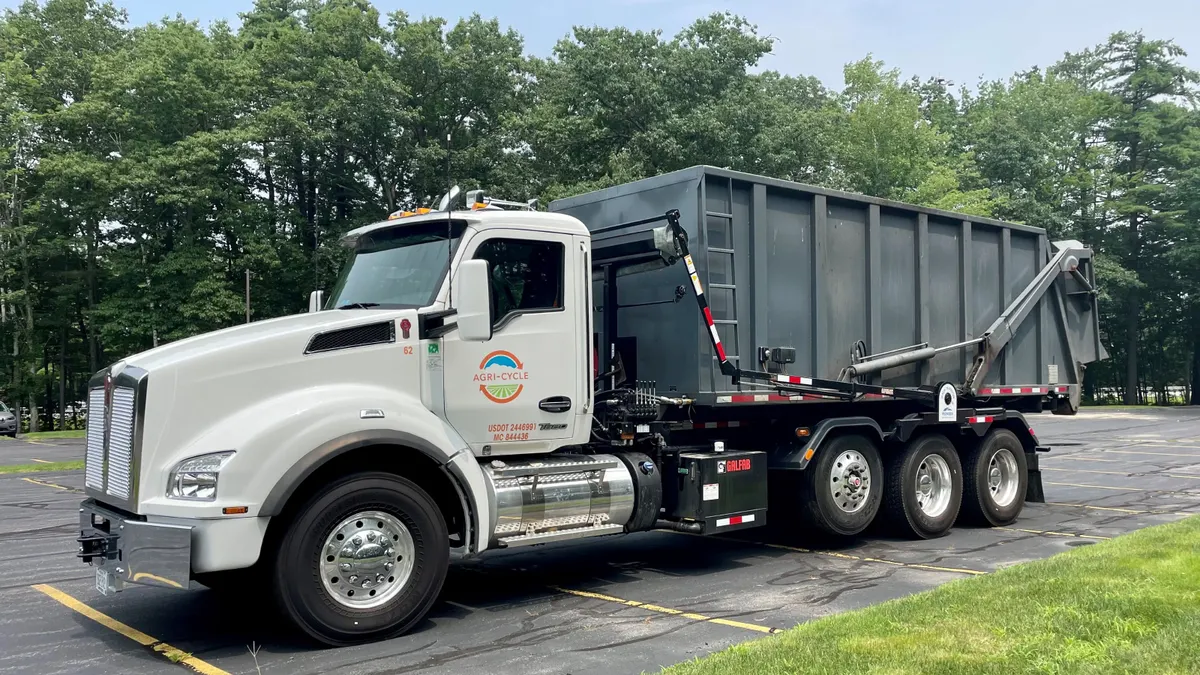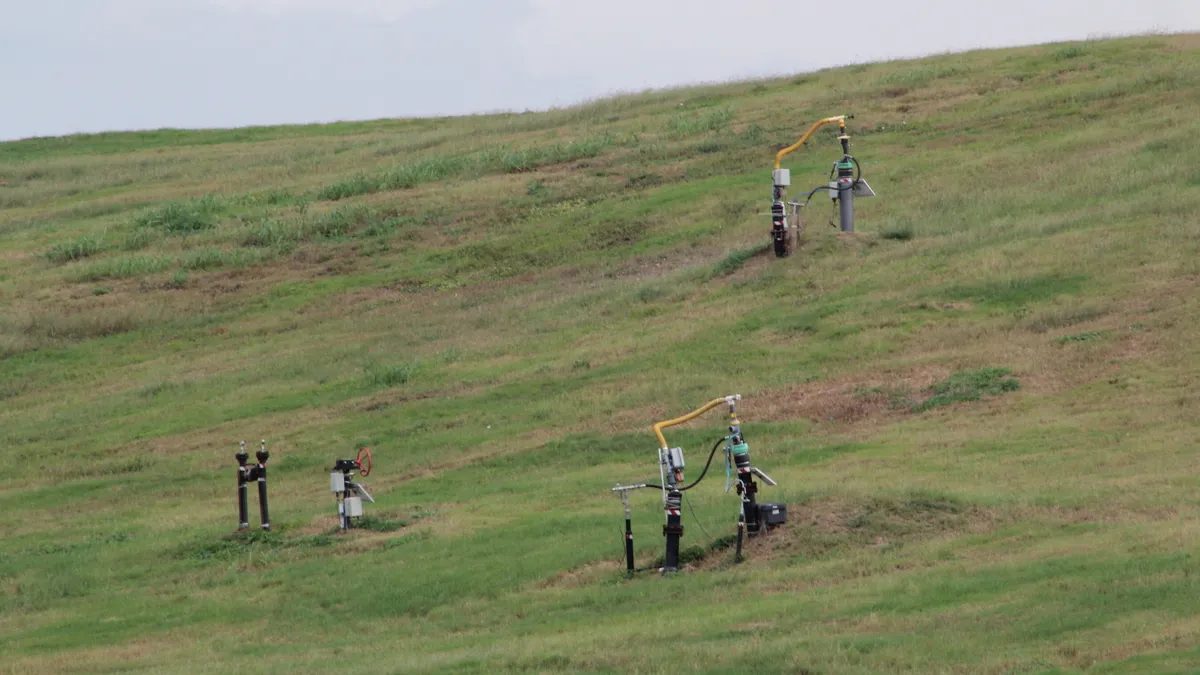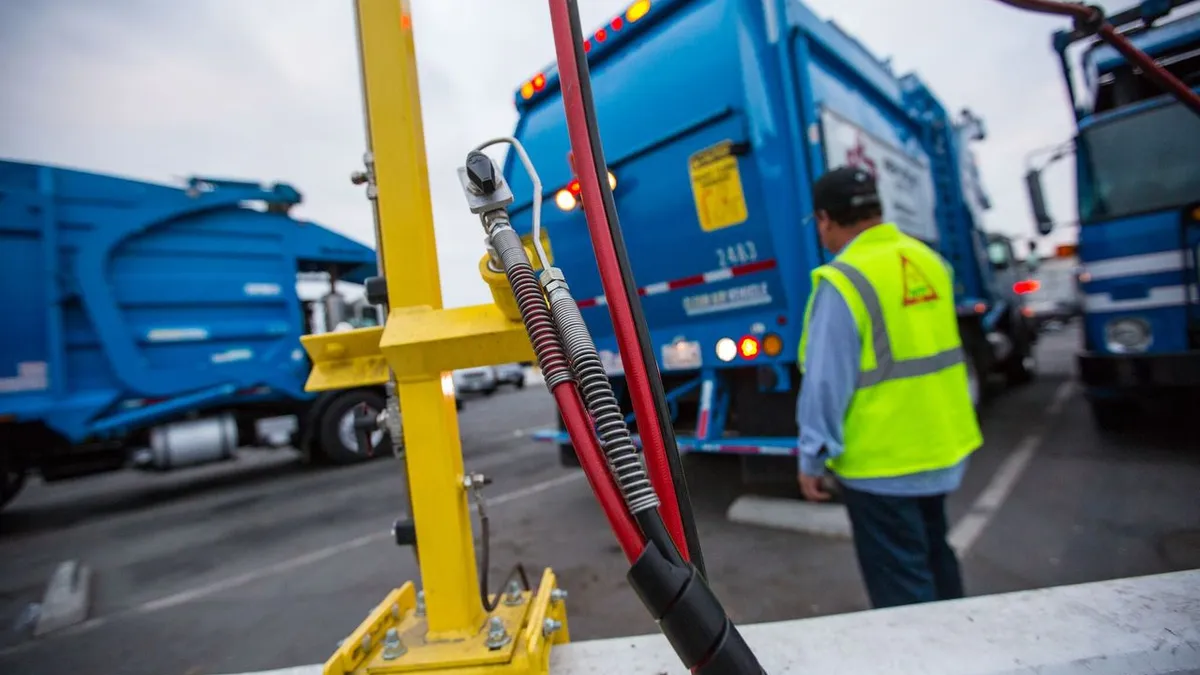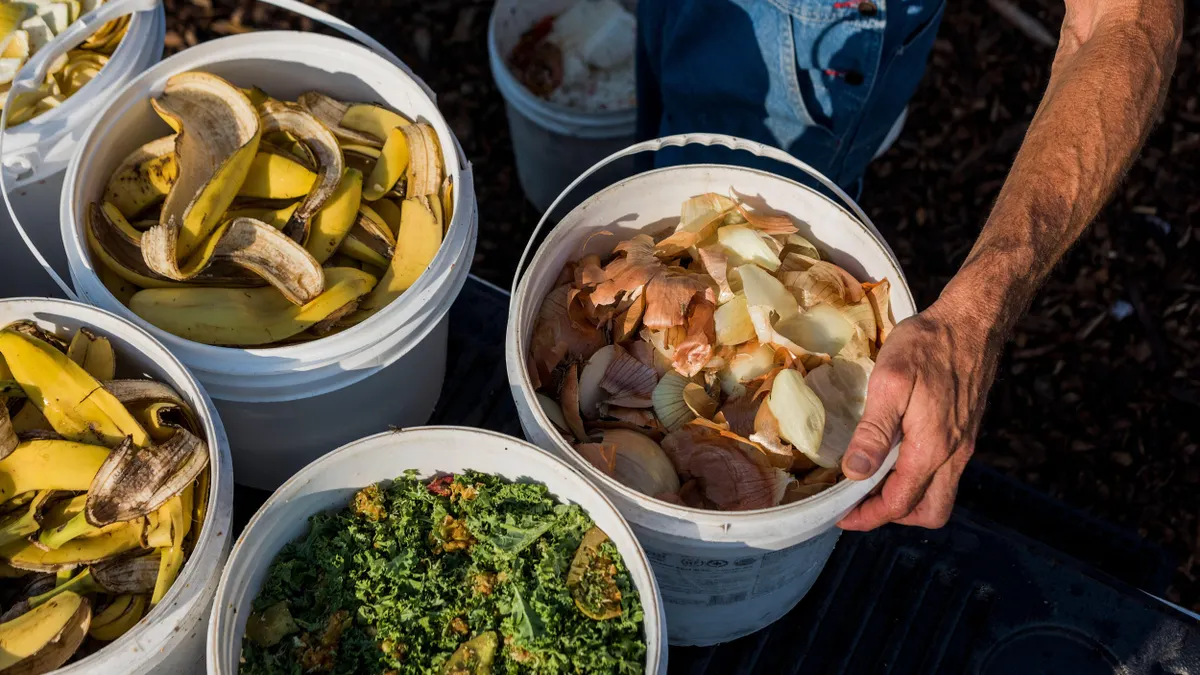Operators champion landfill gas as a source of renewable energy and revenue. But as communities seek to divert more organics and climate anxiety intensifies, the practice has been decried as greenwashing.
The full story of landfill gas (LFG) is complicated.
Capturing LFG creates beneficial use opportunities and earns operators revenue, in addition to reducing the global warming potential of the gas that is successfully captured. However, the system may be imperfect from an economic and environmental standpoint. Other forms of electricity generation from waste have efficiency advantages, and the ability of LFG capture systems to effectively mitigate net greenhouse gas emissions is contested.
Still, major landfill operators often refer to the positive effects of their LFG projects as being on par with other renewable sources.
"[Landfills] really are fantastic in that we generate energy from them that really meets the same needs that the solar industry or the wind industry [meets], and we need to take more credit for that and be really proud of the work we’re doing as a business," Waste Management CFO Devina Rankin said at a WasteExpo panel in May.
Anne Germain, NWRA's vice president of technical and regulatory affairs, explained that LFG is considered renewable because the carbon dioxide emissions generated by organic decomposition at landfills would happen as part of the natural breakdown of recently-living biomass regardless. Because landfills are covered, however, anaerobic digestion happens instead of aerobic digestion, meaning methane, a more potent greenhouse gas, is produced. Operators capture the gas and burn it, rendering it back into carbon dioxide that would have been produced had the waste degraded on the surface, and create energy in the process.
"The energy [captured] is brand new energy that is displacing potential fossil fuels. That's how we look at it," Germain said.
But environmental groups, including Sierra Club and others, have argued that landfill gas capture systems are not effective at mitigating net emissions, because any escaped methane poses a risk.
"The bottom line is, landfill gas-to-energy is hijacking concern for climate change — for a technology and process that actually makes the climate condition substantially worse," Peter Anderson, president of RecycleWorlds Consulting, told Waste Dive.
LFG 101
Buried underground, the organic component of the waste decomposes in the absence of oxygen and produces a combination of carbon dioxide and methane which gradually escapes. Capturing the gas is important because methane is a highly potent greenhouse gas, with 28 to 36 times the warming potential of carbon dioxide, according to the EPA.
The EPA has established rules which require monitoring and installation of gas collection and control systems if emissions exceed a certain threshold. Thus, many large landfills are legally obligated to capture the gas, but have a variety of opportunities when it comes to how to use it.
Gas can be flared (rendering it less potent by conversion to carbon dioxide and water), used directly on site or nearby, or upgraded for sale as renewable natural gas, among other uses, according to the EPA's Landfill Methane Outreach Program (LMOP).
Electricity generation is the most common use by far: according to the NWRA, 74% of U.S. LFG projects generate electricity. Nationwide, about 2.44 GW of capacity are currently installed, enough to power more than a million homes.
Even so, LFG remains a small component of total U.S. electricity generation, accounting for just 0.3% of the total in 2018. Non-landfill municipal solid waste is close behind among biomass sources, at 0.2%. Covanta, which operates many of the country's incinerators, reported 1.62 GW of installed capacity in 2018.
While LFG and incineration have grown slowly in recent years other renewable sources have taken off. According to the Energy Information Administration, the U.S. had 51 GW of solar capacity and 94 GW of wind capacity as of 2018.
Economic and environmental factors
Among waste-based electricity generation sources, landfills are not the most efficient.
"Landfill biogas systems produce about half the amount of biogas from a given volume of organic material that an anaerobic digester does," said Patrick Serfass, president of the American Biogas Council.
Serfass said this is because digesters are optimized to maximize the conversion of organic material to biogas, whereas landfills are not. Digesters are also sealed facilities, so all the biogas produced is captured.
According to LMOP information, 1 million tons of municipal solid waste produces about 0.78 MW of electricity. The capacity of individual landfills varies, but sites with millions of tons of waste often have capacities similar to just a handful of 2 MW wind turbines – and smaller than many incinerators.
13.7 billion tons of waste undergird the 2.44 GW of installed landfill generation capacity in the U.S. By comparison, only about 26 million tons of waste were burned for electricity at the 2.3 GW of incinerator capacity installed in the U.S. in 2015, according to the Energy Information Administration.
This suggests a much higher efficiency for incinerators, although direct comparisons to incineration are difficult, because landfills cannot measure MWh/ton processed directly.
"... the amount of LFG generated at a specific landfill is a function of multiple factors, including waste quantity, waste composition, and the amount of time since the waste was disposed," according to the EPA. That makes MWh/ton processed a less useful metric for LFG projects.
While proponents acknowledge that landfills may be less efficient, they also point out landfills have economic advantages that can make them attractive compared to other forms of energy generation from waste.
"[Digesters] are very expensive as compared to landfills. And so in order to do something like that, there's going to be a huge capital investment," Germain told Waste Dive. Germain noted incinerators can be more expensive upfront, and that few have been built in the U.S. since the 1990s.
The outlook for landfill gas
Despite limited efficiency, gas capture systems provide a return on investment for landfill operators, as a component of overall sustainability efforts and as a source of revenue.
"Landfills are often not the most popular land use," SWANA CEO David Biderman told Waste Dive. "Positioning yourself as a good neighbor from both an environmental and economic perspective is always a goal of landfills."
Among major companies, Waste Management has the most LFG use projects, with 130 (101 of which produce electricity). Republic Services and Waste Connections are second and third, with 75 and 52 projects respectively (electricity versus other uses not specified).
Companies often highlight that LFG can help make waste processing more circular by providing fuel for collection trucks or electricity to buildings, remitting the need to extract diesel and natural gas.
As solar and wind have taken off, and natural gas continues to be cheaply available, the relative value of LFG has declined, according to Biderman. This means LFG plays a smaller role in renewable portfolios today than a decade ago.
"The number of new landfill gas projects installed on an annual basis has certainly decreased over the last few years, and I expect that absent new federal regulations, there will continue to be only slight increases in the number of landfills with new landfill gas facilities," Biderman said.
Germain told Waste Dive the decline in the number of new capture systems is reflective of a decline in the number of new landfills, rather than a lack of interest in using gas where it is economically viable. She also highlighted the fact that local considerations might lead landfills to produce vehicle fuel rather than electricity or pipeline-quality gas, since this can be more cost-effective.
"With CNG vehicles becoming much more common, it becomes a little bit more realistic," Germain said.
In August 2016, the Obama administration created emissions guidelines and source performance standards for landfills. The Trump administration has hedged on enforcement, leading to an ongoing legal back-and-forth.
For smaller landfills, the economics of installing an LFG capture system are not always as advantageous as they are at larger ones. Even where gas is captured, operators do not always take the extra step of converting it to electricity due to the high capital cost of installing the turbine infrastructure. Waste Management, for instance, uses only 55% of captured gas.
The EPA estimates 60–90% of gas is captured at covered landfills, but this range has been met with skepticism by environmental advocates, who say optimizing landfills for gas capture can actually be counterproductive from an emissions standpoint.
"The reality is, in terms of the way landfills operate to produce usable commercial volumes of energy, you have to add a lot of moisture," said Peter Anderson.
Adding moisture accelerates the formation of methane and increases the methane to carbon dioxide ratio. This is good for economic efficiency, but also means more methane has the potential to escape more quickly. Anderson said the 60–90% figure does not accurately reflect the methane capture rate over the entire lifetime of the landfill, since much methane forms and escapes before covers are installed and capture systems are active.
The IPCC has estimated that, depending on circumstances, lifetime LFG capture could be as low as 20% in some cases. According to Anderson, this has serious climate implications, because "even a [small amount more] methane than has been admitted is going to overwhelm whatever gains were promised on the carbon dioxide side of avoidance."
Reached for comment, an EPA spokesperson provided multiple references for the 60-90% capture estimate via email. The agency told Waste Dive the U.S. currently has 46 LFG projects planned or under construction. Advocates also remain optimistic about LFG's potential to serve as a renewable energy source.
"As we look to the future and variations in market conditions, we have over 2,500 MSW landfills in the U.S., and just over 600 right now at which we are currently using their organic resources as energy. The sustainable energy potential is something we should be running after right now, not walking," Marcus Gillette, director of public affairs at the Coalition for Renewable Natural Gas, told Waste Dive.
Over the long term, the fate of LFG is linked to broader societal discussions about the relative value of different ways of handling organic waste and producing energy.
LFG-to-energy projects will continue as long as incentives exist and organics continue to be landfilled in large volumes. If LFG is downgraded as a renewable fuel source, or organics diversion rates start to climb higher, the proportional contribution of LFG to the U.S. electric grid could decline.


